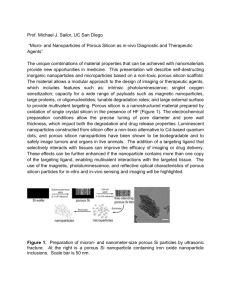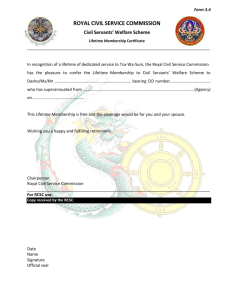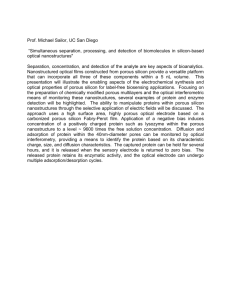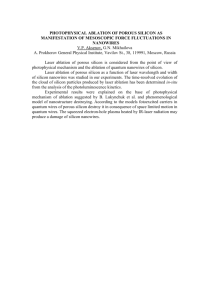Porous Silicon Gettering in Dendritic Web Silicon
advertisement
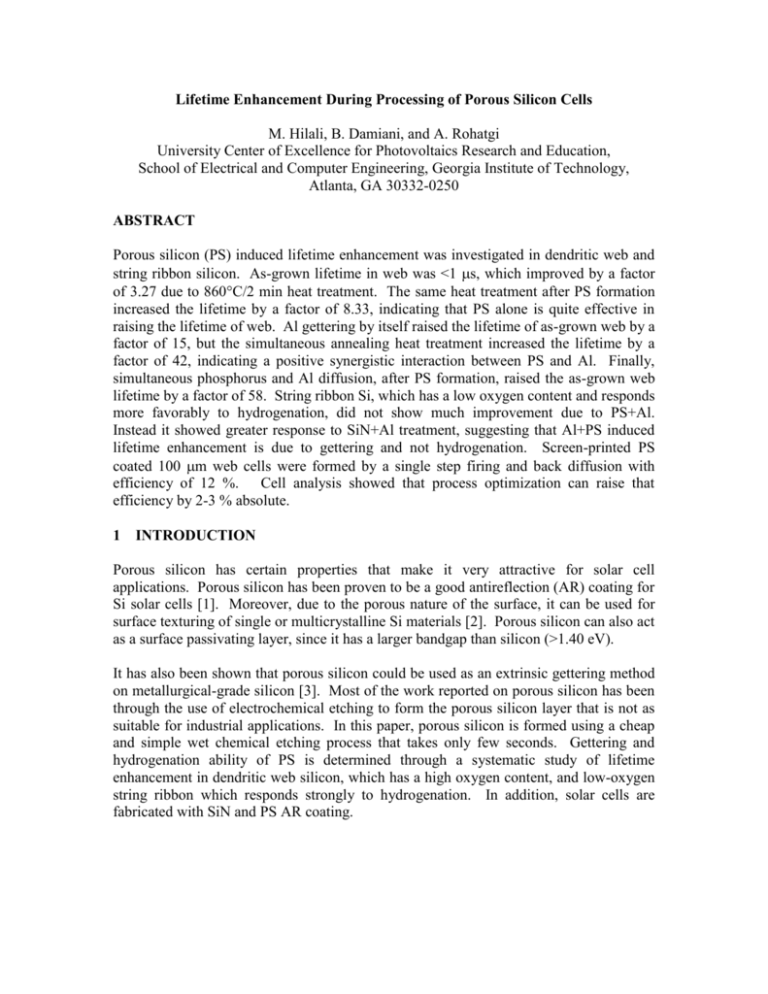
Lifetime Enhancement During Processing of Porous Silicon Cells M. Hilali, B. Damiani, and A. Rohatgi University Center of Excellence for Photovoltaics Research and Education, School of Electrical and Computer Engineering, Georgia Institute of Technology, Atlanta, GA 30332-0250 ABSTRACT Porous silicon (PS) induced lifetime enhancement was investigated in dendritic web and string ribbon silicon. As-grown lifetime in web was <1 s, which improved by a factor of 3.27 due to 860C/2 min heat treatment. The same heat treatment after PS formation increased the lifetime by a factor of 8.33, indicating that PS alone is quite effective in raising the lifetime of web. Al gettering by itself raised the lifetime of as-grown web by a factor of 15, but the simultaneous annealing heat treatment increased the lifetime by a factor of 42, indicating a positive synergistic interaction between PS and Al. Finally, simultaneous phosphorus and Al diffusion, after PS formation, raised the as-grown web lifetime by a factor of 58. String ribbon Si, which has a low oxygen content and responds more favorably to hydrogenation, did not show much improvement due to PS+Al. Instead it showed greater response to SiN+Al treatment, suggesting that Al+PS induced lifetime enhancement is due to gettering and not hydrogenation. Screen-printed PS coated 100 m web cells were formed by a single step firing and back diffusion with efficiency of 12 %. Cell analysis showed that process optimization can raise that efficiency by 2-3 % absolute. 1 INTRODUCTION Porous silicon has certain properties that make it very attractive for solar cell applications. Porous silicon has been proven to be a good antireflection (AR) coating for Si solar cells [1]. Moreover, due to the porous nature of the surface, it can be used for surface texturing of single or multicrystalline Si materials [2]. Porous silicon can also act as a surface passivating layer, since it has a larger bandgap than silicon (>1.40 eV). It has also been shown that porous silicon could be used as an extrinsic gettering method on metallurgical-grade silicon [3]. Most of the work reported on porous silicon has been through the use of electrochemical etching to form the porous silicon layer that is not as suitable for industrial applications. In this paper, porous silicon is formed using a cheap and simple wet chemical etching process that takes only few seconds. Gettering and hydrogenation ability of PS is determined through a systematic study of lifetime enhancement in dendritic web silicon, which has a high oxygen content, and low-oxygen string ribbon which responds strongly to hydrogenation. In addition, solar cells are fabricated with SiN and PS AR coating. 2 EXPERIMENTAL A simple and low-cost chemical etching was used to form the porous silicon layers on both surfaces of the material. The PS layer was formed in a few seconds (~10 sec), using H2O:HNO3:HF solution in the ratio10:9:3. The Si samples were cleaned using an RCA sequence before the initial as-grown lifetime measurement by the quasi-state photoconductance (QSSPC) technique [4]. After the desired heat treatment, all the layers (aluminum, porous silicon, SiN or any diffusion layer) were etched from the sample and the bulk lifetime was measured again using the photoconductance technique. Silicon nitride was deposited using PECVD at 300C, with a refractive index of 1.98 and a thickness of 850 Å, which densifies to 780 Å and 2.03 index of refraction after all the firing steps. Aluminum back-surface field (BSF) was formed by screen-printing Al on the back and firing it in the belt furnace at 860C for 2 minutes. The phosphorus was diffused using a phosphorus solid-source placed on top of the Si sample as it travels through the belt furnace. For the lifetime studies, heat treatments involving phosphorus diffusion were performed at 860C for 6 minutes, while all other heat treatments were performed at 860C for 2 minutes. However, for cell fabrication, simultaneous diffusion of screen-printed Al on the back and solid source phosphorus on the front was achieved in the belt furnace at 880C for 20 minutes in order to obtain ~45 /sq. emitter. 3 INDIVIDUAL AND COMBINED EFFECTS OF PHOSPHORUS, ALUMINUM AND POROUS SILICON TREATMENTS Figure 1 shows the effect of various heat treatments, individually and in combination. Normalized lifetime represents the change in lifetime divided by the starting lifetime (/s). Fig. 1 shows that PS, Al, PS+P, P+Al treatments improve the sub-microsecond lifetime of a 1.3 -cm web by a factor in the range of 3 to 15. However, the PS+Al combination increased the bulk lifetime by a factor of ~42, which is greater than the sum of individual effects of PS and Al. This indicates a positive synergistic interaction between Al and PS. Finally, simultaneous diffusion of SP Al on the back and solidsource P on the front of the PS layer at 860C for 6 minutes improved the bulk lifetime by a factor of 58, resulting in an absolute lifetime of 17.9 on 1.3 -cm p-type web Si. The same treatment improved the bulk lifetime of a 5 -cm p-type web Si by a factor of 59, resulting in a final lifetime of 45 s. 58.70 39.05 41.59 16.00 15.10 N ul -> ta Al ne ou s P /A l/P S Al Si m P>S i PS + + Si N + P Al Al P -> PS (A l) O nl y Si N Al um in um Po ro us Si H 9.64 7.08 0.02 (P S ea t 8.33 )O nl y 3.27 O nl y Normalized Improvement in Lifetime Improvement in Lifetime Due to Different Heat Treatments 70 60 50 40 30 20 10 0 Figure 1. Normalized improvement in lifetime due to individual and combined effects of PS, Al, and P. In the literature [5], the synergistic effect of aluminum and porous silicon has been attributed to enhanced defect passivation due to hydrogen diffusion from the porous Si surface. Hydrogen diffusion can be enhanced due to vacancies generated by Al alloying at the back. It is important to note that unlike other ribbon materials, dendritic web has a high oxygen content, which is known to hinder hydrogenation. This is supported by the fact that SiN induced hydrogenation has little effect on web bulk lifetime. On the other hand, SiN+Al heat treatment is found to be very effective for lifetime enhancement in low-oxygen string ribbon silicon, which is known to improve significantly with hydrogenation [6]. Notice that PS+Al treatment has a much less effect on lifetime of string ribbon relative to SiN+Al treatment. This suggests that PS+Al does not provide as good a source of hydrogenation as the SiN+Al treatment. Hence, the significant lifetime enhancement in high-oxygen dendritic web silcon due to Al+PS treatment is attributed to gettering of impurities rather than defect passivation due to hydrogen. More work is needed to prove this point. Normalized Improvement in Lifetime in String Ribbon for Different Heat Treatments 45 40 35 30 25 20 15 10 5 0 Normalized Lifetime Improvement Lifetime ( s) Lifetime Enhancement in String Ribbon Due to Different Heat Treatments Starting Lifetime Final Lifetime Heat only PS only SiN Al only PS+Al SiN+Al 4.5 4 3.5 3 2.5 2 1.5 1 0.5 0 PS only SiN Figure 2. Porous Si and Al heat treatments for string ribbon materials. Al only PS+Al SiN+Al 4 FABRICATION AND ANALYSIS OF PS CELLS ON WEB SILICON Manufacturable screen-printed n+-p-p+ solar cells were fabricated with PS or SiN AR coating on 0.6 -cm. SP Al BSF and solid-source phosphorus emitter were formed simultaneously, after the PS formation, to maximize the bulk lifetime. Notice that, unlike most prior investigations, the PS layer was formed before and not after the diffusion. Finally, the screen-printed Ag contacts were fired through the PS layer. Conventional SiN AR coated cells were also fabricated for comparison. As shown in Table I, PS cells gave 12 % efficiency while the SiN coated cells were 13 %, primarily due to the difference in Jsc. IQE and reflectance analysis, Fig. 3, showed that the IQE of both cells were quite similar and the difference in Jsc can be totally accounted for by the higher reflectance of PS cells. This is because PS reflectance properties changed during the diffusion process. We need to tailor the starting PS layer reflectance so that after diffusion and contact firing, which can change the porosity and thickness of the PS layer, we get 10 % reflectance instead of 18 % obtained in this experiment. In addition, diffusion for the PS cell was done at 880C for 20 minutes to obtain the right emitter sheet resistance, while the lifetime enhancement studies were done at 860C for 6 minutes. Further process optimization is needed to obtain appropriate reflectance, sheet resistance and lifetime in the finished PS devices. Table I. Comparison of SiN and PS cell performance. Cell ID Voc(mV) Jsc(mA/cm2) FF Eff(%) Rs (-cm2) Rsh (-cm2) P0.6 PS 602 26.32 0.757 12 0.98 3111 P0.6 SiN 606 28.41 0.753 13 0.9 3665 IQE and Reflectance Plots for SiN and Porous Si p-type Web Cells 100 80 P0.6 with SiN front layer P0.6 with porous Si % 60 40 Porous Si cell reflectance SiN cell reflectance 20 0 400 600 800 1000 1200 W avelength (nm) Figure 3. Internal quantum efficiency plots of a PS and a SiN coated cell. 5 CONCLUSIONS This study shows that PS is capable of enhancing bulk lifetime of mc-Si materials and this improvement is amplified by the presence of Al on the back during the heat treatment. Porous silicon induced enhancement is material specific. It appears that materials like web, which respond strongly to gettering, show greater improvement due to PS+Al treatment. Materials like string ribbon, which respond positively to hydrogenation, showed better response due to the Al+SiN treatment than the Al+PS treatment. This suggests that PS induced lifetime enhancement is due to gettering, resulting from the stress and damage induced impurity sink in the PS layer. Screenprinted PS cells were fabricated by simultaneous front and back diffusion, after the PS formation. Initial results on PS cells are encouraging. Further, process optimization may close the gap between SiN and PS cells. REFERENCES [1] P. Menna, G. Di Francia, and V. La Ferrara “Porous silicon in solar cells: A review and a description of its application as an AR coating,” Solar Energy Materials and Solar Cells, 37, 1995, pp.12-24. [2] R. R. Bilyalov, B. Groh, H. Lautenschlager, R. Schindler, and F. Schomann, “Screen printed Multicrystalline Silicon Solar Cells with Porous Silicon Antireflection Coating,” Proc. Of the 26th PVSC, Anaheim, CA, Sept.30-Oct. 3, 1997, pp. 147-150. [3] Y.S. Tsuo, P. Menna, J.R. Pitts, K.R. Jantzen, S.E. Asher, M.M. Al-Jassim, and T.F. Ciszek, “Porous Silicon Gettering,” Proc. of the 25th PVSC, Washington, D.C., May 13-17, 1996, pp. 461-464. [4] D. Macdonald and A. Cuevas, “Trapping of minority carriers in multicrystalline silicon,” Applied Physics Letters, Vol. 74, No. 12, 1999, pp. 1710-1712. [5] R. Bilyalov, Z. Matic, J. Poortsmans, F. Schomann, W. Schmidt, “Synergistic Effect of Aluminum and Thermally Treated Porous Silicon For Bulk Passivation of Multicrystalline Silicon,” Proc. of the 28th PVSC, Anchorage, Alaska, September 2000, pp. 291-294. [6] A. Rohatgi, V. Yelundur, J. Jeong, A. Ebong, D. Meier, A. M. Gabor, and M.D. Rosenblum, ”Aluminum-Enhanced PECVD SINx Hydrogenation in Silicon Ribbons,” in Proc. of the 16th European Photovoltaic Solar Energy Conference, Glasgow, United Kingdom, Vol. II, May 2000, pp. 1120-1123.
